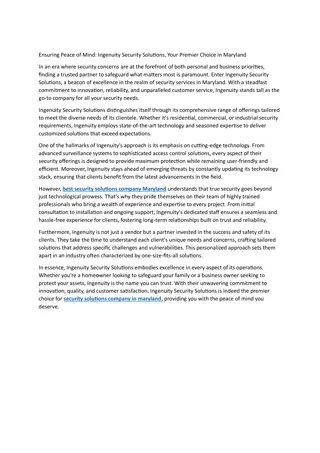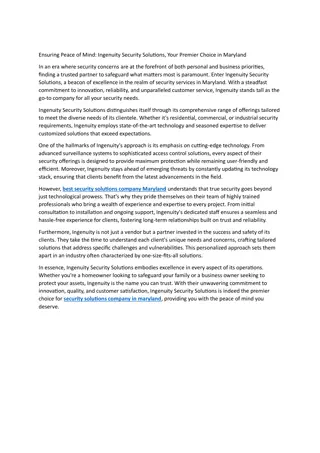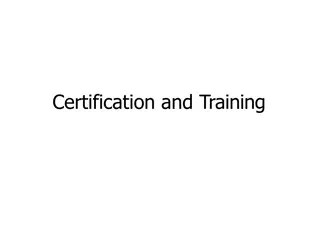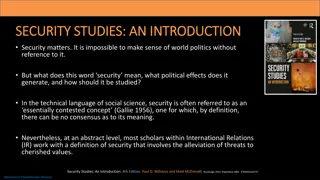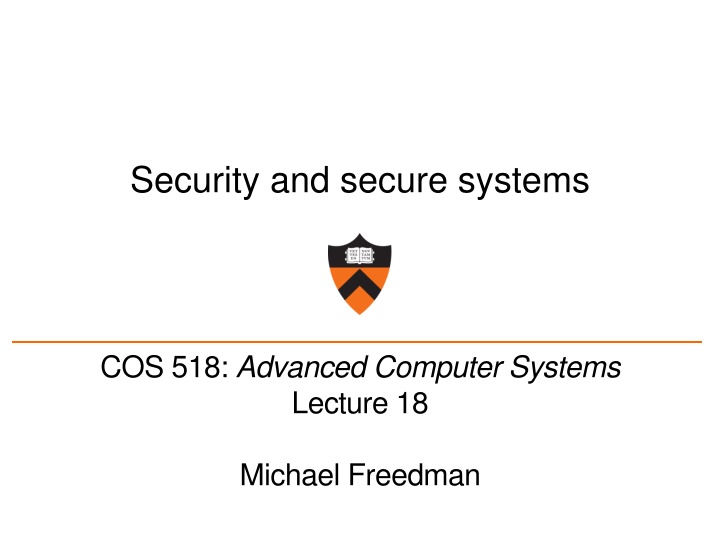
Advanced Computer Systems Lecture on Security and Cryptography
Explore the concepts of security, cryptography, symmetric and public-key encryption, RSA algorithm, and cryptographic hash functions in this advanced computer systems lecture. Understand the importance of confidentiality, integrity, and authentication in secure systems.
Download Presentation

Please find below an Image/Link to download the presentation.
The content on the website is provided AS IS for your information and personal use only. It may not be sold, licensed, or shared on other websites without obtaining consent from the author. If you encounter any issues during the download, it is possible that the publisher has removed the file from their server.
You are allowed to download the files provided on this website for personal or commercial use, subject to the condition that they are used lawfully. All files are the property of their respective owners.
The content on the website is provided AS IS for your information and personal use only. It may not be sold, licensed, or shared on other websites without obtaining consent from the author.
E N D
Presentation Transcript
Security and secure systems COS 518: Advanced Computer Systems Lecture 18 Michael Freedman
What is Cryptography? From Greek, meaning secret writing Confidentiality: encrypt data to hide content Include signature or message authentication code Integrity: Message has not been modified Authentication: Identify source of message encryption decryption ciphertext plaintext plaintext Modern encryption: Algorithm public, key secret and provides security Symmetric (shared secret) or asymmetric (public-private key) 3
Symmetric (Secret Key) Crypto Sender and recipient share common key Main challenge: How to distribute the key? Provides dual use: Confidentiality (encryption) Message authentication + integrity (MAC) 1000x more computationally efficient than asymmetric 5
Public-Key Cryptography Each party has (public key, private key) Alice s public key PK Bob uses PK to encrypt messages to Alice ciphertext = encrypt (message, PK) Bob uses PK to verify signatures from Alice isValid = verify (signature, message, PK) Alice s private/secret key: sk Alice uses sk to decrypt ciphertexts sent to her message = decrypt (ciphertext, sk) Alice uses sk to generate new signatures on messages signature = sign (message, sk) 6
(Simple) RSA Algorithm Generating a key: Generate composite n = p * q, where p and q are secret primes Pick public exponent e Solve for secret exponent d in d e 1 (mod (p -1) (q 1)) Public key = (e, n), private key = d Encrypting message m: c = me mod n Decrypting ciphertext c: m = cd mod n Security due to cost of factoring large numbers Finding (p,q) given n takes O(e log n log log n) operations n chosen to be 2048 or 4096 bits long 7
Cryptographic hash function ( and using them in systems ) 8
Cryptography Hash Functions I Take message m of arbitrary length and produces fixed-size (short) number H(m) One-way function Efficient: Easy to compute H(m) Hiding property: Hard to find an m, given H(m) Assumes m has sufficient entropy, not just { heads , tails } Random: Often assumes for output to look random 9
Cryptography Hash Functions II Collisions exist: | possible inputs | >> | possible outputs | but hard to find Collision resistance: Strong resistance: Find any m != m such that H(m) == H(m ) Weak resistance: Given m, find m such that H(m) == H(m ) For 160-bit hash (SHA-1) Finding any collision is birthday paradox: 2^{160/2} = 2^80 Finding specific collision requires 2^160 10
Hash Pointers h = H( ) (data) 11
Self-certifying names Fname = H( ) (data) P2P file sharing software (e.g., Limewire) File named by Fname = H (data) Participants verify that H (downloaded) == Fname 12
Self-certifying names Cname = H( ) H( ) H( ) H( ) H( ) chunk chunk chunk chunk chunk BitTorrent Large file split into smaller chunks (~256KB each) Torrent file specifies the name/hash of each chunk Participants verify that H (downloaded) == Cname Security relies on getting torrent file from trustworthy source 13
Hash chains H( ) prev: H( ) prev: H( ) prev: H( ) data data data Creates a tamper-evident log of data 14
Hash chains H( ) prev: H( ) prev: H( ) prev: H( ) data data data If data changes, all subsequent hash pointers change Otherwise, found a hash collision! 15
Examples: HTTP and DNS security 16
Securing HTTP Threat model Eavesdropper listening on conversation (confidentiality) Man-in-the-middle modifying content (integrity) Adversary impersonating desired website (authentication, and confidentiality) Enter HTTP-S HTTP sits on top of secure channel (SSL/TLS) All (HTTP) bytes written to secure channel are encrypted and authenticated Problem: What is actually authenticated to prevent impersonation? Which keys used for crypto protocols? 17
Learning a valid public key What is that lock? Securely binds domain name to public key (PK) Believable only if you trust the attesting body Bootstrapping problem: Who to trust, and how to tell if this message is actually from them? If PK is authenticated, then any message signed by PK cannot be forged by non-authorized party 18
The trouble with CAs Browse/OS vendors pick which CAs to trust Sometimes they revoke this trust e.g. DigiNotar. No notion of CAs having authority over only given TLD Trust the {Iranian, Chinese, US} national authorities? What standards does Apple use to pick root certs? Google? MSFT? There s a restraint-of-trade issue here. Can t enter the CA business without vendor support 22
DNS Security 23
Hierarchical naming in DNS unnamed root zw arpa uk com edu org ac generic domains country domains in- addr bar ac west east 12 cam foo my 34 usr my.east.bar.edu usr.cam.ac.uk 56 12.34.56.0/24 24
DNS Integrity: Trust the TLD operators? If domain name doesn t exist, DNS should return NXDOMAIN (non-existant domain) msg Verisign instead creates wildcard DNS record for all .com and .net domain names not yet registered September 15 October 4, 2003 Redirection for these domain names to Verisign web portal: to help you search and serve you ads and get sponsored search Verisign and online advertising companies make money 25
DNS Integrity: Answer from authoritative server? DNS cache poisoning Client asks for www.evil.com Nameserver authoritative for www.evil.com returns additional section for (www.cnn.com, 1.2.3.4, A) Thanks! I won t bother check what I asked for 26
DNS Integrity: Answer from authoritative server? To prevent cache poisoning, client remembers domain and 16-bit request ID (used to demux UDP response) But DNS hijacking attack: - 16 bits: 65K possible IDs - What rate to enumerate all in 1 sec? 64B/packet - 64*65536*8 / 1024 / 1024 = 32 Mbps - Prevention: Also randomize the DNS source port - Windows DNS alloc s 2500 DNS ports: ~164M possible IDs - Would require 80 Gbps - Kaminsky attack: this source port wasn t random after all 27
Lets strongly believe the answer! Enter DNSSEC The DNS servers sign the hash of resource record set with its private (signature) keys Public keys can be used to verify the SIGs Leverages hierarchy: Authenticity of nameserver s public keys is established by a signature over the keys by the parent s private key In ideal case, only roots public keys need to be distributed out- of-band 28
Verifying the tree Question: www.cnn.com ? . (root) dns.cs.princeton.edu src.cs.princeton.edu ask .com server SIG (ip addr and PK of .com server) www.cnn.com A ? stub resolver resolver xxx.xxx.xxx.xxx www.cnn.com A ? .com transaction signatures ask cnn.com server SIG (ip addr and PK of cnn.com server) add to cache slave servers transaction signatures cnn.com 29










